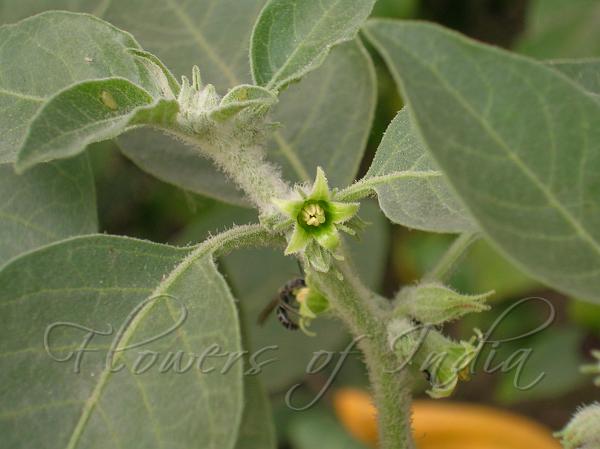|
| Ashwagandha |
|

|

| File size | 671469 |
| Original date | 2/12/06 2:27 PM |
| Resolution | 2048 x 1536 |
| Flash | Flash did not fire, auto |
| Focal length | 13.6mm |
| Exposure time | 1/91s |
| Aperture | 4.3 |
| Focus Distance | |
| Metering Mode | Partial |
| Camera make | NIKON |
| Camera model | E3700 |
| Sensor type |
|
|
|
Photo: |
Botanical name: Withania somnifera Family: Solanaceae (Potato family)
 Ashwagandha, is native to drier parts of India. It is a perennial herb that
reaches about 6 feet in nature. It is a short, tender perennial herb growing
35-75 cm tall. Velvet-hairy branches extend radially from a central stem.
Leaves are dull green, elliptic, usually up to 10-12 cm long. The flowers
are small, green and bell-shaped. Orange fruits in
persistent papery sepals follow the small greenish flowers.
Ashwagandha is propagated by division, cuttings or seed. Seed is the
best way to propagate them.
A postal stamp was issued by the Indian Postal Department to commemorate this
flowers.
Ashwagandha, is native to drier parts of India. It is a perennial herb that
reaches about 6 feet in nature. It is a short, tender perennial herb growing
35-75 cm tall. Velvet-hairy branches extend radially from a central stem.
Leaves are dull green, elliptic, usually up to 10-12 cm long. The flowers
are small, green and bell-shaped. Orange fruits in
persistent papery sepals follow the small greenish flowers.
Ashwagandha is propagated by division, cuttings or seed. Seed is the
best way to propagate them.
A postal stamp was issued by the Indian Postal Department to commemorate this
flowers.
Medicinal uses:
 Ashwagandha has been a prized top notch adaptogenic
tonic in India for 3000 - 4000 years.
The plants contain the alkaloids withanine and somniferine, which are used to
treat nervous disorders, intestinal infections and leprosy.
All plant parts are used including the roots, bark, leaves, fruit and seed.
Ashwagandha has been a prized top notch adaptogenic
tonic in India for 3000 - 4000 years.
The plants contain the alkaloids withanine and somniferine, which are used to
treat nervous disorders, intestinal infections and leprosy.
All plant parts are used including the roots, bark, leaves, fruit and seed.
| Identification credit: Tabish | Photographed in the Garden of Five Senses, Delhi |
• Is this flower misidentified? If yes,